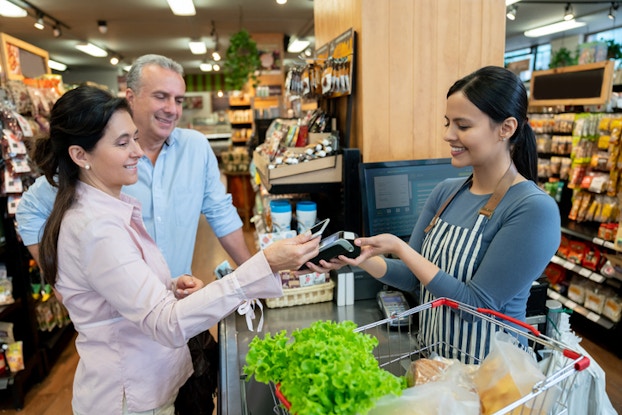
Just walk out. Grab and go. Tap and pay. These catchy calls to action entice shoppers to get on their way fast, whether exiting an Uber ride or a store that has no checkout lanes.
Technology enabling next-generation cashless transactions comes in many forms – such as chip-embedded key fobs, smartphones, and mobile ride-sharing apps. Amazon Go’s artificial intelligence technology lets shoppers bypass the checkout line, and as one Yelp reviewer boasted, get in and out with a purchase in 17 seconds’ time.
Because these transactions do not require PIN code entry, credit slip signatures or cash handling, they are super speedy. While no one pretends to know what technology ultimately will win over the masses, consumers’ increasing demand for speed and convenience signals it’s time for businesses to craft a mobile payment strategy, O Alliance Founding Partner Andrea Weiss told CO—.
U.S. adoption of mobile payments lags behind countries like China, but this is changing gradually, she said.
“You just need to stand in a busy Starbucks in a major urban area to see the adoption of their mobile payment app or tap/pay,” Weiss added. “Once your daily lunch spot trains you to only pay with your mobile, what is next? It will reinforce and build on the momentum.”
Airlines have already trained travelers that cash is not accepted for in-flight cocktails, while some restaurants and cafes go cashless to reduce wait times during peak periods.
“There is a trend to optimize around convenience. Whether it’s Apple Pay, whatever the medium is, matters less,” Zebra IQ CEO and Founder Tiffany Zhong told CO—. Zebra IQ is a consulting firm advising brands about Generation Z, the youngest consumer group that arrived after Millennials.
“It’s more about what is the most convenient for consumers. Most consumers have a smartphone and that is why there is a trend of people wanting to pay with their phones. That’s one less thing to carry,” said Zhong. She pointed to Dirty Lemon’s cashless store in New York, facilitating payment via text messages, as a payments innovation to watch.
Cashless concerns
While cashless is gaining in popularity, it also has its detractors. The city of Philadelphia and the state of New Jersey both banned cashless stores in March. San Francisco followed with similar legislation in May while officials in New York City, Chicago and Washington, D.C., are now considering laws requiring businesses to accept cash.
Cashless opponents cite discrimination against consumers who prefer to pay with cash and those with no other option, such as the 14 million U.S. adults counted by the Federal Deposit Insurance Corp. (FDIC) as “unbanked” with no access to credit.
The backlash prompted cashless pioneer Sweetgreen to reverse its policy and by year-end 2019, its 94 salad shops will revert back to accepting cash.
It’s more about what is the most convenient for consumers.Tiffany Zhong, CEO and founder, Zebra IQ
Even Amazon Go made a concession to cash: In May, it opened its 12th convenience store, the first to accept cash payment. Weiss doesn’t see these developments having a chilling effect on mobile payments.
“The reality is that if you ask a big box retailer what percentage of their business is cash, credit card, gift card, you will find that cash has gone down,” Weiss said. “Ultimately, customer preferences will rule.” Consumers making all or nearly all of their purchases in cash fell to 18% last year, down from 24% in 2015, according to Pew Research.
Among those undeterred by the outcry is Danny Meyer, CEO of Union Square Hospitality Group and founder of Shake Shack. In 2018, Meyer explained why his company was going cashless. Meyer cited the security, speed and efficiency benefits cashless offers. Last month, he reminded Fortune readers that it wasn’t long ago cash-only restaurants were regarded as discriminatory for refusing to accept credit cards.
Don’t forget the fundamentals
“Sometimes bright, shiny objects don’t deliver the expected outcome as a holistic picture hasn’t been established,” said Edward Wong, EVP, chief merchant and digital officer at Smart & Final, the $4.7 billion Commerce, Calif., grocery chain. He told CO— that retailers should focus on reducing friction across the entire shopping journey. Cashless payment may play a role but execution on the fundamentals, such as reducing out-of-stocks, is important.
“Look at the roadblocks to speed and ease of checkout, then within that laundry list, is cashless on the top, middle or bottom relative to value?” he asked. “Without looking at the entire shopping journey and identifying all the interaction and break points, cashless capability and its priority may not be clear.”
Weiss said businesses need not be on the bleeding edge. “There is a lot of safety in the middle ground,” she said. “I watch consumers. It is about pacing them and staying just a little bit ahead…That is a lot better than being the last guy to adopt, that little gazelle that’s broken away from the pack is the one to get picked off.”
CO— aims to bring you inspiration from leading respected experts. However, before making any business decision, you should consult a professional who can advise you based on your individual situation.
CO—is committed to helping you start, run and grow your small business. Learn more about the benefits of small business membership in the U.S. Chamber of Commerce, here.

Interested in a small business membership?
Find out how the U.S. Chamber of Commerce can help your company grow and thrive in today's rapidly-evolving business environment. Connect with our team to learn how a small business membership can benefit your bottom line and help you achieve your goals.




